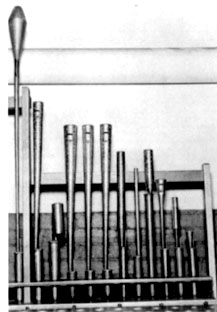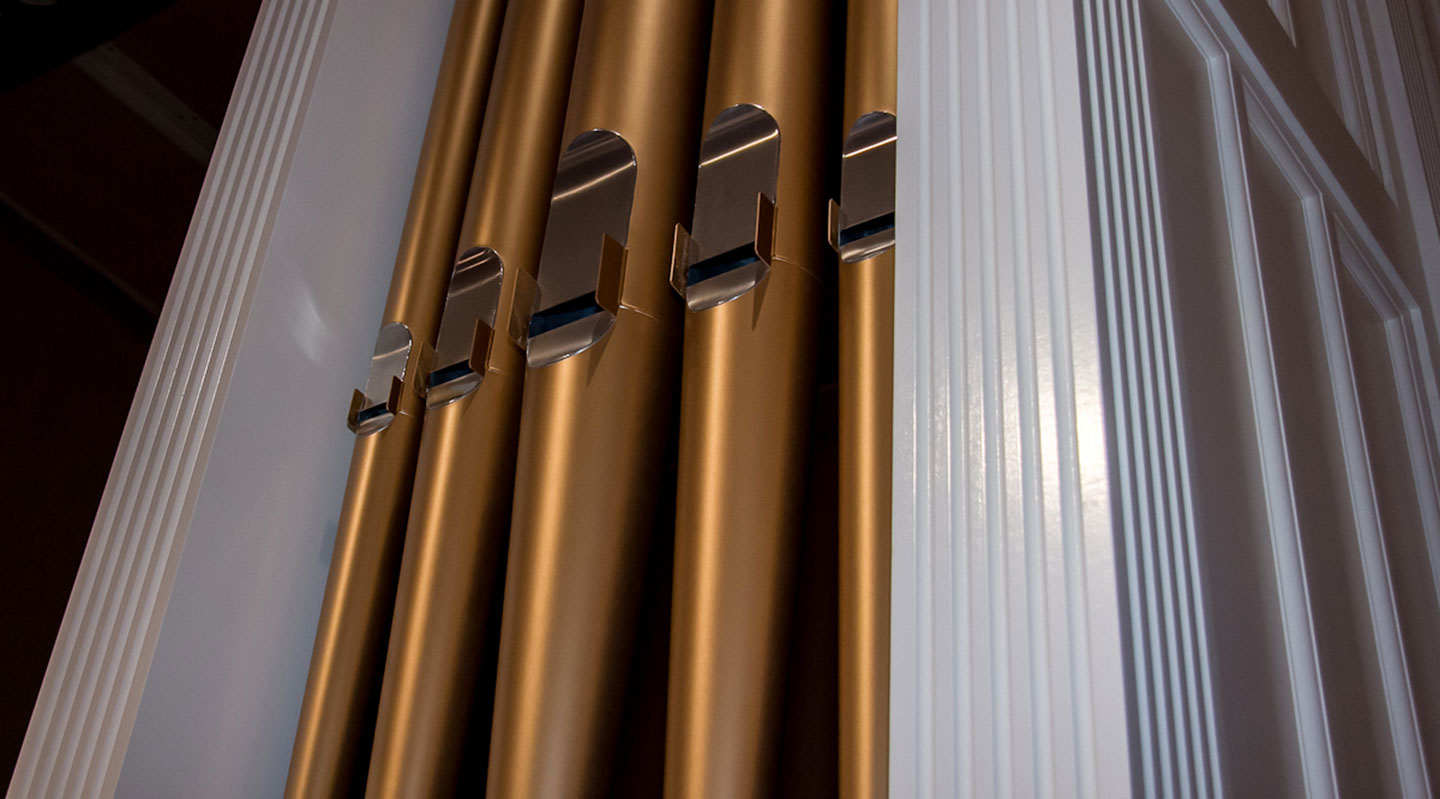Reed Stops
Reeds belong to the family of beating reeds and produce their tone differently than the flute families. Reed tone is produced by the beating of a brass reed tongue, which is held tightly against the brass shallot. Wind pressure from the windchest sets the reed into motion. Once the tone is produced by this, it is further reinforced, colored and tuned by the resonator. This resonator can be of various shapes and sizes. Labial Reeds are the classification of pipes that produce imitative reed tone without the vibrating reed tongue. This tone is produced by flues pipes that have been voiced to emphasize specific harmonic characteristics to appear to resemble a reed pipe. (Labial Oboe, Saxophone).
The reed tongue is nothing more than a flat, thin, springy piece of brass. The shallot is also made of brass but is more like a hollow tube, which is closed at one end. One face of the shallot is perfectly flat and the hollow center appears on this face as a slot. This slot can be either tapered (like a trapezoid) or straight (rectangle). Both the shallot and the tongue are held firmly into the block by the wedge. The wedge can be wooden or made of brass. A tuning wire also passes through the block. This wire is bent in such a way as to apply pressure at the appropriate spot on the reed tongue to produce the desired tuned pitch. By gently tapping the wire up or down, the pitch is determined by the length of the vibrating part of the reed. The block, is cast from lead, and is the part of the pipe that holds the tongue, shallot (secured by the wedge) and the wire. The resonator is soldered onto the block, which is then set into the boot. Just as its name implies, the boot acts as the pipe foot.
When the reed tongue is pressed against the flat face of the shallot an air seal is produced. Conversely when the tongue is allowed to spring back, air can flow into the shallot once more. This alternating pattern produces a raw sound wave. The reed tongue must be curved precisely to produce a pleasing tone. When properly curved, the tongue will roll down the shallot as it covers the opening creating a round, musical sound. If the tongue is improperly curved it will beat against the shallot and produce a harsh, unmusical noise or may make no sound at all.
Reed tongues are of varying lengths and thickness (according to the wind pressure and desired tone). Larger varieties such as those of 8′, 16′ or 32′ pitches employ a small weight applied to the tip of the tongue to introduce mass in order to “quicken” the starting of these larger pipes.
Reeds include the following list of stop names and although their tonal characters can be as different as night and day, they are all members of the reed family of pipes. Trumpet, Oboe, Clarinet, Clarion, Fagott, Bombarde, Posaune, Tromba, Trombone, Tuba, Tuba Mirabalis, Contra Trompette, Trompette, Hautbois, Krummhorn, Schalmei, Rohr Schalmei, Regal, Vox Humana, Bassoon, Flugel Horn, Cor Anglais, French Horn, Orchestral Oboe, Mussette, Dulzian, Trumpet Enchamade, Chalameu, Ophicleide, Festival Trumpet.
Reeds are very sensitive to dirt. The smallest particle of dust between the reed tongue and the shallot can render a pipe silent or cause it to fly “off speech”. Dirty reeds have to be disassembled and cleaned, then reassembled and tuned. A loose wedge can also cause similiar problems. Once again the pipe needs to be disassembled and the wedge tightened.
Reeds can be tuned either on the wire, or at the top. Most reed pipe resonators are slotted at the top and utilize the metal cut from the slot as a tuning scroll. Tuning reeds in this manner (at the top) is the preferred method over tuning on the wire. The reason for this is that tuning the reeds on the wire shortens or lengthens the vibrating toungue thereby changing the volume and color of the note. In fact, this is how the tuner regulates the reeds. Reed voicing and regulation can be a bit time-consuming but the result is a beautifully even sound throughout the compass of the stop. Melodies sing when played on a well-voiced and regulated solo reed and the sound of the ensemble is enlivened by the controlled “fire” which the reeds can add.
Reed pipes, like other pipes, can last for generations. With care and judicious tuning the resonators will remain straight and the scrolls will stay tight. However, over the years reeds can show the scars of time. Resonators become dented or bent, and scrolls can break or become loose. Pipe bodies can separate from the block or split at the rear seam. All of these conditions harm the sound and make tuning difficult. Broken pipes need attention and should be repaired. Loose scrolls can make accurate tuning a chore and also produce unwanted rattles.
We at Patrick J. Murphy & Assoc. are ready and able to take care of your reeds. From routine tuning and regulation, to straightening, cleaning and repairing, our knowledgeable and experienced staff are uniquely equipped to serve you.
Voicing Room Specimen Pipes
A rack of Reed pipes photographed in a voicing room. This set of pipes, always in front of the voicer, helps him to adjust and tune new pipes to the standard of these pipes. All speak from the middle C key.

From the left:
- English Horn 16′
- Fagotto 16′
- Rankett 16′
- Trompette 8′
- Trompette (smaller scale) 8′
- Trompette (shallot variation 8′
- Clarinet 8′
- Krummhorn 8′
- Vox Humana 8′
- Hautbois 4′
- Rohrschalmei 4′
- Fagotto (short) 4′

